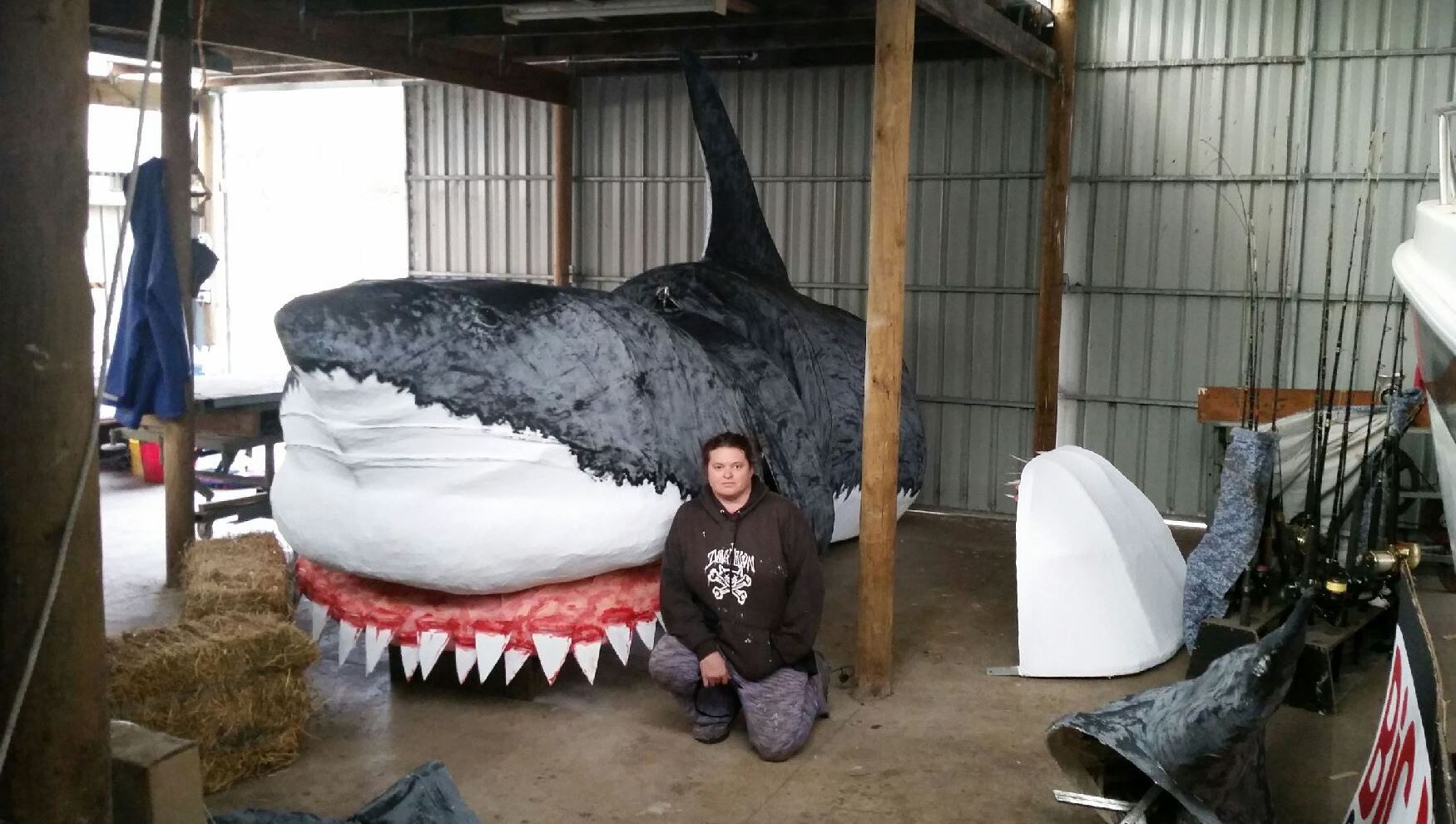
by Tracie Griffith
Julie Hoey has made quite a splash in the Port Fairy Moyneyana Festival’s New Year’s Eve Parade, winning Best Float for the past three years – in 2014 with her stunning Four Horsemen of the Apocalypse float, in 2015 with her dramatic Trojan Horse float and in 2016 with her larger-than-life Big Ben float.
Tales of a monster great white shark named Big Ben are legendary in Port Fairy’s fishing industry. Julie chose the theme in 2016 as a tribute to her grandfather, James Hoey, and other local fishermen, who told stories about their many encounters with Big Ben over the years.
“It’s important to tell these stories to the younger generations,” said Julie. “Some locals think the Big Ben story is bullshit – they think it’s a myth. It’s not. My grandfather saw it. My uncle saw it. Big Ben was real. I wanted to bring the story onto the streets and to get the kids questioning, ‘Who’s Big Ben? What are they on about?’ He inspires the little ones.”
The float depicts the well-known account of Big Ben biting the end of Reuben Kelly’s fishing boat. You can read more about Big Ben and Reuben Kelly’s story on our HOME page.
Julie’s grandfather and uncle recounted the story of their encounter with Big Ben, who they discovered under their boat one day at Lady Julia Percy Island. James Hoey could see Big Ben’s head at one end of the boat and Julie’s Uncle Dessie could see the tail at the other end – so he was as long as their 6 metre (20 foot) boat. They slowly raised the anchor and drifted away from the shark, before starting the boat’s engine and making a dash for it back to Port Fairy.
“My grandfather said Big Ben’s head was as large as the bonnet of a car,” said Julie. “The fishermen named him Big Ben after the clock tower in London, which was considered a large building in those days.”
The story that hasn’t been told is of the last minute drama that almost prevented the Big Ben float from making it to the parade. The float had been built in two sheds at different locations. When it was finally put together, it proved too large to make the turn out of the driveway into the street. This was a serious concern as there were numerous corners the float would have to negotiate along the processional route, along with a large crowd of spectators.
The working party of around 10 people (on the day) sprang into action and set about solving each problem in turn. Big Ben’s tail was resting on the trailer and had to be loosened off so the float could make the sharp turns without the shark’s body splitting apart. The tail was then thrashing about wildly and it was feared that someone in the crowd might be struck by it.
In double-quick time, a fence was constructed around the edges of the trailer to restrict Big Ben’s tail movements, a decorative border of waves was attached to the fence, and handlers were positioned to monitor the progress of the float on its journey.
During the procession, Julie walked in front of the float, the driver was on full alert and a handler followed at the rear – all connected with walkie-talkies to ensure the crowd’s safety. At the intersection of Sackville and Bank Streets, the driver had to steer the widest possible arc, veering onto the roundabout so the float would make it around the corner.
There was also a handler inside the shark, working the tail with a pair of reins.
“Chris Moore was on the reins inside the shark,” said Julie. “And he was getting rope burn from trying to control the tail. He was also using his feet to move the bottom jaw – to scare the kids.”
It was difficult to anticipate the challenges involved in recreating Big Ben on dry land. Julie built a clay model to begin with and her team worked from that. The shark was initially constructed out of chicken wire and paper-mâche around a metal framework, but when the dorsal fin melted in the sunlight through a skylight, Julie tried calico and lacing the fin in place, much like a corset. When this worked, she resolved to cover the entire shark in a layer of calico to ensure it would not easily break apart when transported.
Julie is now busy developing her business ‘Majestic Murals’ and her success with the floats has attracted several commissions. Her current project is the recreation of a heritage mural for the Port Fairy Angling Club on Gipps Street. She enjoys the challenge of large-scale projects and would like to continue working on murals for both exterior and interior locations.
“Murals are bigger, better, and they stop people in their tracks,” she said. “Paintings are cool on a wall, but if you have an entire wall as an art work, it makes people stop and think. And not everyone knows how to paint a mural – how to recreate small images on a massive scale.”
As well as the Port Fairy Angling Club, you can see examples of Julie’s mural work at the Four Seasons Chinese Restaurant in Sackville Street and at the ‘Grief Garden’ at Brauer College in Warrnambool. Julie is also contributing artwork to the Port Fairy Ghost Stories project.